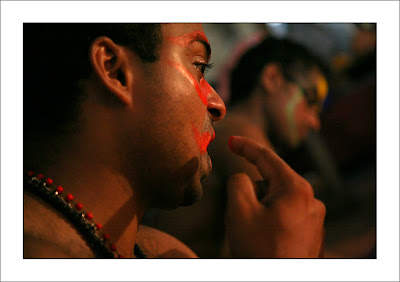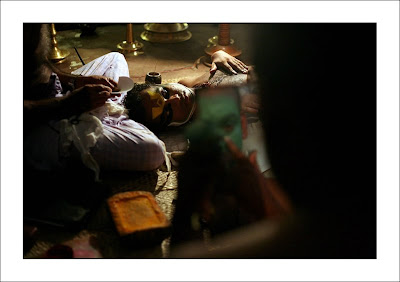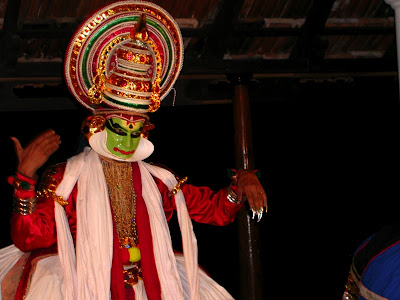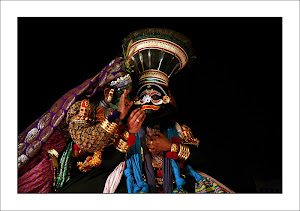Tuesday, January 12, 2010
Tuesday, December 4, 2007
Kathakali --- Traditional Dance Of Kerala
Kathakali is one of the oldest theatre forms in the world. It originated in the area of southwestern India now known as the state of Kerala. Kathakali is a group presentation, in which dancers take various roles in performances traditionally based on themes from Hindu mythology, especially the two epics, the Ramayana and the Mahabharata.
Kathakali is powerful, challenging and unique.
It is a wonderful combination of Drama, Dance, Music, Poetry, Costume, Makeup and ritual where each unique element merges in perfect harmony to create total theatre.
Courtesy to photos taken by Yan Seiler of Switzerland.
Posted by
RJ
at
5:11 AM
0
comments
![]()
kathakali Make up before perfomance
One of the most interesting aspects of Kathakali is its elaborate make-up code. Most often, the make-up can be classified into five basic sets namely Pacha, Kathi, Kari, Thaadi, and Minukku. The differences between these sets are the predominant colors that are applied on the face.


Pacha (Pacha=green)has green as the dominant color and is used to portray noble male characters who is said to have a mixture of "Satvik" (pious)and "Rajasic" (kingly)nature.

Rajasic characters having an evil streak ("tamasic"= evil), such as the demon king Ravana, are portrayed with red as the predominant color in a green background. Excessively evil characters such as demons (totally tamasic) have a predominantly red make-up and a red beard. They are called Chuvanna Thaadi(Red Beard). Tamasic characters such as uncivilized hunters are represented with a predominantly black make-up base and a black beard and are called Kari/ Karutha Thaadi (meaning black beard). 


Women and ascetics have lustrous, yellowish faces and form the fifth class. In addition there are modifications of the five basic sets described above such as Vella Thadi (white beard) used to depict Hanuman (the monkey god) and Pazhuppe, which is used for the Sun God.

The make up is made from various mineral ores and pigments. They are ground on a stone and mixed with coconut oil before being applied on the face. Some characters also have their features enhanced, such as an enlarged nose or an elaborate mustache. There are made using elaborately cut paper which is stuck to the face with a mixture of rice paste and calcium carbonate.

Dancers also often place a "chundanga seed" (variety of eggplant which bears small fruits) under their lower eyelid before the performance to turn the white of their eyes red. In fact the "chundanga" is not really a seed and is prepared by removing the ovaries at the base of the flowers of this plant. The procedure used for preparing these seeds involves the rubbing of a bunch of these in your palm until they become black (starting from a white color) and nearly dehydrated. They often last long enough for a season (of around four months) in this condition.
Posted by
RJ
at
4:26 AM
0
comments
![]()






















